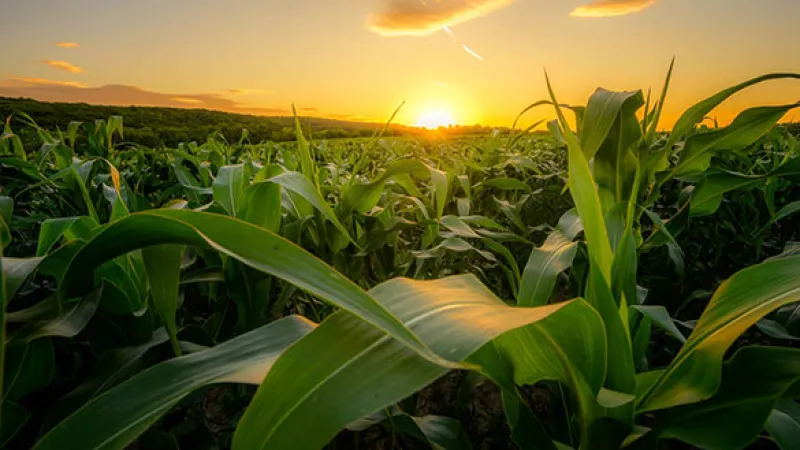Emily Balsamo, CME Group
AT A GLANCE
- Some indications suggest that high volatility is the new normal for grains
- The volatility of 2022 has disrupted the historic correlation between Chicago and Kansas City Wheat futures
1. The Russo-Ukrainian War
Prior to the February 2022 Russian invasion of Ukraine, volatility in grains lingered around 25 on CME’s CVOL Index; with Chicago wheat slightly above, and Corn futures slightly below in late 2021. Rising tensions in Ukraine were reflected in rising CVOL for Chicago Wheat in early 2022, with an explosion in volatility in early March 2022 following the February 24 invasion on the back of fears surrounding a global wheat shortage. Volatility in corn, which is also produced in the Black Sea region and demand for which would increase in times of shortage in other grains, also peaked during that period. Wheat volatility has since hovered significantly above pre-war levels in recent months, though corn has seen a return to normalcy in its CVOL. Wheat also sees a dramatically higher options skew of late.Follow Grain Market Volatility with CVOL
Chicago v. Kansas City Wheat Futures
The volatility of 2022 has disrupted the historic correlation between Chicago and Kansas City Wheat futures. Each point in the figure above represents the leading Chicago and Kansas City Wheat futures settlement prices with respect to one another on each trade date over the past decade. 2022 dates are indicated by a red color and show markedly higher prices than years past. The five dates indicated by the blue circle, which deviate more from the historic relationship than any dates over the past ten years, represent the Chicago and Kansas City Wheat futures settlement prices on trade dates March 4-8, 2022.
During that week, front-month Chicago Wheat futures daily settlement prices exceeded Kansas City Wheat pricing (the latter being generally priced higher due to higher protein content and thus perceived higher quality), as Chicago wheat is more liquid and thus more strongly reflected the geopolitical shock. Indeed, wheat production in Ukraine is expected to decrease significantly in the current crop year compared to 2021/22, though losses would be offset by abundant harvests in Russia and Canada. In its November 2022 global supply and demand report, the USDA forecasts world wheat production in 2022/23 to exceed the prior crop year by 3.2 million tons.
Read More on Chicago – Kansas City Wheat Dynamics
Although a feared worldwide wheat shortage has been avoided, uncertainty surrounding Black Sea wheat supply is high. Free transport of Black Sea wheat by Ukrainian ships is dependent on a grain deal between Russia and Ukraine struck in July 2022, in which Russia agreed to grant safe passage to cargo ships from Ukrainian ports through the Bosporus strait dividing the Black Sea and the Mediterranean. According to the United Nations Black Sea Grain Initiative, a group within the international governing body monitoring the situation, more than 10 million tons of cargo have passed since August 3, 2022; 42% of which by weight was corn and 28% wheat. Adding to the confusion and hampered logistics, Russia withdrew from the deal in October 2022 only to rejoin in early November.
2. Business Uncertainty and Pandemic Hangover
Deeply interconnected with the Russo-Ukrainian war and its effects on global food pricing is an atmosphere of general uncertainty from the lingering COVID-19 Pandemic.The Federal Reserve’s target inflation rate is meant to provide predictable prices for consumers and producers, mitigating price risk while allowing for freer economic growth than zero inflation would allow. For years of the 2010’s, for example, inflation fell short of the Fed’s 2% target, indicative of an era of low wage growth and price stagnation. During this period the Fed was hampered in raising interest rates from the ~0% Effective Federal Funds Rate (EFFR)for fear of dampening inflation further, suppressing economic growth.
Flash forward to 2022, when inflation has become a worldwide phenomenon and some annual Consumer Price Index (CPI) data points have showed double digit price growth, shocking consumers and producers alike. In response, the Fed has been engaging in an aggressive interest rate regimen, moving the EFFR target from 0.00-0.25 in March 2022 to 3.75-4.00 after their November 2022 meeting. Although raising interest rates is meant to contribute to price stability by reigning in inflation, unpredictable monetary policy can pose a risk of its own by creating uncertainty around borrowing costs.
Both inflation and rising interest rates have created uncertainty this year, with a grain producer in early 2022, for example, not knowing both the input and borrowing costs they will face in the 2022/23 crop year, a year anticipated to see high input costs even before the Russo-Ukrainian War and unforeseen inflation dominated headlines.
One major input to all production, from farming to processing, is oil, which although reaching a price détente in 2022, experiences sustained volatility, compounding uncertainty in commodity markets.
3. Weather Complicates Mississippi Transport
Any discussion of the factors underpinning grain markets would be remiss without weather. Growing conditions in the United States have been fair in 2022, with corn progress in late October (88%) nearing a five-year high, despite dryness in the Midwest and South that has depressed Mississippi River water levels. According to American Farm Bureau Federation, low water levels have resulted in lower draft allowances for barges, which limit the volume of goods a barge may carry. As a result, the season has seen a reduction in cargo of over 20% per barge on the Mississippi. Such a reduction per barge means more barges are needed to transport the same amount of cargo, resulting in record high barge rates.
Chicago Wheat Term Structure Volatility to 2024
Is This the New Normal?
Risk demands reward: a producer facing input and borrowing risks will respond with higher prices. When the risk profile of a market is ever-changing, prices of that asset will change too, resulting in volatility. 2022 has been a wild ride, and just as there is indication that high volatility is the new normal, some indicators suggest a future tendency towards stability. The November 9, 2022 CPI, for example, showed a 7.7% increase in inflation in the year through October 2022; a reduction from both analyst expectations of 7.9% and the 8.2% marked from the year ending the month prior and a signal that the Fed’s aggressive monetary policy may be working.At the same time, many of the other factors underlying volatility persist: the Russo-Ukrainian War the supply chain issues stemming from the pandemic at the root of inflation continue. Climate change will continue to create uncertain conditions globally, even as crops become more resilient. The volatility term structure of the Chicago Wheat options market is forecasting elevated levels of volatility until December 2023, demonstrating that agriculture markets will continue to reflect financial, monetary, and geopolitical risk.






